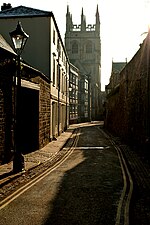Corpus Christi College, Oxford

Corpus Christi College (formally, Corpus Christi College in the University of Oxford; informally abbreviated as Corpus or CCC) is one of the constituent colleges of the University of Oxford in the United Kingdom. Founded in 1517, it is the 12th oldest college in Oxford. The college, situated on Merton Street between Merton College and Christ Church, is one of the smallest in Oxford by student population, having around 250 undergraduates and 90 graduates. It is academic by Oxford standards, averaging in the top half of the university's informal ranking system, the Norrington Table, in recent years, and coming second in 2009–10.The college's role in the translation of the King James Bible is historically significant. The college is also noted for the pillar sundial in the main quadrangle, known as the Pelican Sundial, which was erected in 1581. Corpus achieved notability in more recent years by winning University Challenge on 9 May 2005 and once again on 23 February 2009, although the latter win was later disqualified.The Visitor of the college is ex officio the Bishop of Winchester, currently Tim Dakin.
Excerpt from the Wikipedia article Corpus Christi College, Oxford (License: CC BY-SA 3.0, Authors, Images).Corpus Christi College, Oxford
Magpie Lane, Oxford City Centre
Geographical coordinates (GPS) Address Website Nearby Places Show on map
Geographical coordinates (GPS)
| Latitude | Longitude |
|---|---|
| N 51.750909 ° | E -1.253702 ° |
Address
Corpus Christi College
Magpie Lane
OX1 4ES Oxford, City Centre
England, United Kingdom
Open on Google Maps









